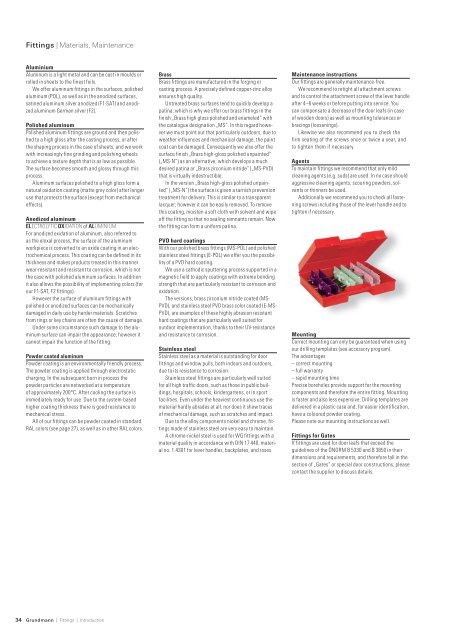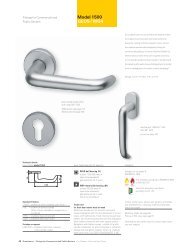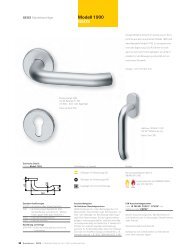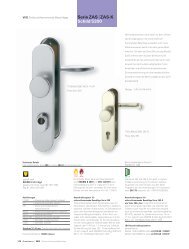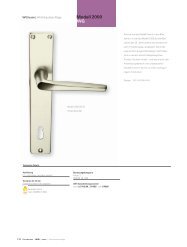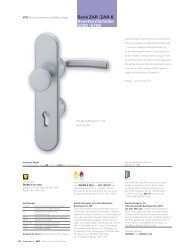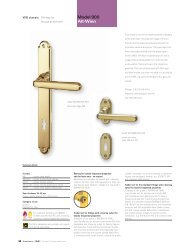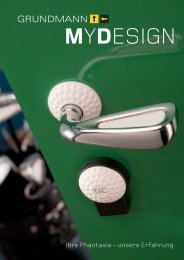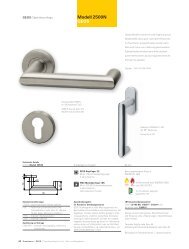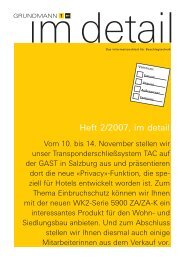CATALOGUE 2010/11 - Grundmann Beschlagtechnik GmbH
CATALOGUE 2010/11 - Grundmann Beschlagtechnik GmbH
CATALOGUE 2010/11 - Grundmann Beschlagtechnik GmbH
You also want an ePaper? Increase the reach of your titles
YUMPU automatically turns print PDFs into web optimized ePapers that Google loves.
Fittings | Materials, Maintenance<br />
Aluminium<br />
Aluminum is a light metal and can be cast in moulds or<br />
rolled in sheets to the finest foils.<br />
We offer aluminum fittings in the surfaces, polished<br />
aluminum (POL), as well as in the anodized surfaces,<br />
satined aluminum silver anodized (F1-SAT) and anodized<br />
aluminum German silver (F2).<br />
Polished aluminum<br />
Polished aluminum fittings are ground and then polished<br />
to a high gloss after the casting process, or after<br />
the shaping process in the case of sheets, and we work<br />
with increasingly fine grinding and polishing wheels<br />
to achieve a texture depth that is as low as possible.<br />
The surface becomes smooth and glossy through this<br />
process.<br />
Aluminum surfaces polished to a high gloss form a<br />
natural oxidation coating (matte grey color) after longer<br />
use that protects the surface (except from mechanical<br />
effects).<br />
Anodized aluminum<br />
ELECTROLYTIC OXIDATION of ALUMINIUM<br />
For anodized oxidation of aluminum, also referred to<br />
as the eloxal process, the surface of the aluminum<br />
workpiece is converted to an oxide coating in an electrochemical<br />
process. This coating can be defined in its<br />
thickness and makes products treated in this manner<br />
wear-resistant and resistant to corrosion, which is not<br />
the case with polished aluminum surfaces. In addition<br />
it also allows the possibility of implementing colors (for<br />
our F1-SAT, F2 fittings).<br />
However the surface of aluminum fittings with<br />
polished or anodized surfaces can be mechanically<br />
damaged in daily use by harder materials. Scratches<br />
from rings or key chains are often the cause of damage.<br />
Under some circumstance such damage to the aluminum<br />
surface can impair the appearance; however it<br />
cannot impair the function of the fitting.<br />
Powder coated aluminum<br />
Powder coating is an environmentally friendly process.<br />
The powder coating is applied through electrostatic<br />
charging. In the subsequent burn in process the<br />
powder particles are networked at a temperature<br />
of approximately 200°C. After cooling the surface is<br />
immediately ready for use. Due to the system-based<br />
higher coating thickness there is good resistance to<br />
mechanical stress.<br />
All of our fittings can be powder coated in standard<br />
RAL colors (see page 27), as well as in other RAL colors.<br />
Brass<br />
Brass fittings are manufactured in the forging or<br />
casting process. A precisely defined copper-zinc alloy<br />
ensures high quality.<br />
Untreated brass surfaces tend to quickly develop a<br />
patina, which is why we offer our brass fittings in the<br />
finish „Brass high gloss polished and enameled“ with<br />
the catalogue designation „MS“. In this regard however<br />
we must point out that particularly outdoors, due to<br />
weather influences and mechanical damage, the paint<br />
coat can be damaged. Consequently we also offer the<br />
surface finish „Brass high-gloss polished unpainted“<br />
(„MS-N“) as an alternative, which develops a much<br />
desired patina or „Brass zirconium nitride“ („MS-PVD)<br />
that is virtually indestructible.<br />
In the version „Brass high-gloss polished unpainted“<br />
(„MS-N“) the surface is given a tarnish prevention<br />
treatment for delivery. This is similar to a transparent<br />
lacquer; however it can be easily removed. To remove<br />
this coating, moisten a soft cloth with solvent and wipe<br />
off the fitting so that no sealing remnants remain. Now<br />
the fitting can form a uniform patina.<br />
PVD hard coatings<br />
With our polished brass fittings (MS-POL) and polished<br />
stainless steel fittings (E-POL) we offer you the possibility<br />
of a PVD hard coating.<br />
We use a cathodic sputtering process supported in a<br />
magnetic field to apply coatings with extreme bonding<br />
strength that are particularly resistant to corrosion and<br />
oxidation.<br />
The versions, brass zirconium nitride coated (MS-<br />
PVD), and stainless steel PVD brass color coated (E-MS-<br />
PVD), are examples of these highly abrasion resistant<br />
hard coatings that are particularly well suited for<br />
outdoor implementation, thanks to their UV-resistance<br />
and resistance to corrosion.<br />
Stainless steel<br />
Stainless steel as a material is outstanding for door<br />
fittings and window pulls, both indoors and outdoors,<br />
due to its resistance to corrosion.<br />
Stainless steel fittings are particularly well suited<br />
for all high traffic doors, such as those in public buildings,<br />
hospitals, schools, kindergartens, or in sport<br />
facilities. Even under the heaviest continuous use the<br />
material hardly abrades at all, nor does it show traces<br />
of mechanical damage, such as scratches and impact.<br />
Due to the alloy components nickel and chrome, fittings<br />
made of stainless steel are very easy to maintain.<br />
A chrome-nickel steel is used for WG fittings with a<br />
material quality in accordance with DIN 17 440, material<br />
no. 1.4301 for lever handles, backplates, and roses.<br />
Maintenance instructions<br />
Our fittings are generally maintenance-free.<br />
We recommend to retight all attachment screws<br />
and to control the attachment screw of the lever handle<br />
after 4–6 weeks or before putting into service. You<br />
can compensate a decrease of the door leafs (in case<br />
of wooden doors) as well as mounting tolerances or<br />
bracings (loosenings).<br />
Likewise we also recommend you to check the<br />
firm seating of the screws once or twice a year, and<br />
to tighten them if necessary.<br />
Agents<br />
To maintain fittings we recommend that only mild<br />
cleaning agents (e.g. suds) are used. In no case should<br />
aggressive cleaning agents, scouring powders, solvents<br />
or thinners be used.<br />
Additionally we recommend you to check all fastening<br />
screws including those of the lever handle and to<br />
tighten if necessary.<br />
Mounting<br />
Correct mounting can only be guaranteed when using<br />
our drilling templates (see accessory program).<br />
The advantages<br />
– correct mounting<br />
– full warranty<br />
– rapid mounting time<br />
Precise boreholes provide support for the mounting<br />
components and therefore the entire fitting. Mounting<br />
is faster and also less expensive. Drilling templates are<br />
delivered in a plastic case and, for easier identification,<br />
have a coloured powder coating.<br />
Please note our mounting instructions as well.<br />
Fittings for Gates<br />
If fittings are used for door leafs that exceed the<br />
guidelines of the ÖNORM B 5330 and B 3850 in their<br />
dimensions and requirements, and therefore fall in the<br />
section of „Gates“ or special door constructions, please<br />
contact the supplier to discuss details.<br />
34 <strong>Grundmann</strong> | Fittings | Introduction


